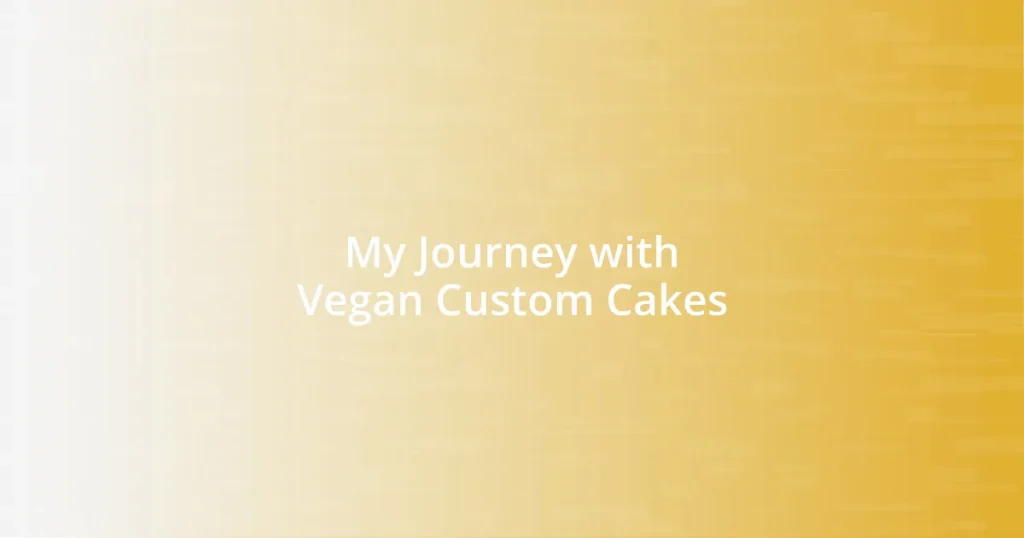Key takeaways:
- Vegan custom cakes utilize innovative plant-based ingredients like almond milk and flaxseed, enhancing flavor and texture while being compassionate alternatives.
- Transitioning to a vegan lifestyle is accessible through gradual changes and community support, enriching the cooking experience with new ingredients and flavors.
- Personalization in cake design, using colors, textures, and meaningful elements, elevates the celebration experience, connecting it to personal stories and memories.
- Key baking tips include using aquafaba as an egg substitute and experimenting with various plant-based fats to achieve the desired cake texture.

Understanding Vegan Custom Cakes
Vegan custom cakes are a delightful blend of creativity and compassion, tailored to suit both taste and dietary preferences. I still remember the first time I tasted a vegan cake—its moistness and flavor surprised me, challenging my preconceived notions. Have you ever found yourself hesitant to try something new, only to discover it was a game-changer?
What sets vegan cakes apart is the innovative use of plant-based ingredients like almond milk, flaxseed, and coconut oil. These substitutes not only enhance the flavor but also add unique textures that can elevate the cake experience. I once experimented with a chocolate avocado cake that was so rich and satisfying, it completely changed my view on what a cake should be. It made me wonder: how many other wonderful combinations are waiting to be discovered in the world of vegan baking?
Creating custom cakes allows for personalization beyond just flavors; it’s about crafting an experience. I’ve seen the joy on friends’ faces when they realize a cake can be both stunning and free from animal products. It’s that moment of connection and surprise that reminds me why I love this journey. How do you envision your perfect cake, and can it be made vegan while still being that delicious centerpiece you crave? The answer is a resounding yes!

Transitioning to a Vegan Lifestyle
Transitioning to a vegan lifestyle can feel like a daunting task, but I found it to be a rewarding journey. The key for me was to take small steps—switching one animal product at a time. I still remember my first swap; I replaced cow’s milk with almond milk, and the change was surprisingly seamless. Have you ever experienced a simple change that led to a much larger lifestyle shift?
As I delved deeper, I discovered countless resources like cookbooks and online communities that supported my transition. Connecting with others who shared this journey was invaluable. I recall joining a local vegan group and sharing recipes; it felt empowering to be part of a community passionately committed to a similar cause. Isn’t it fascinating how relationships can flourish over shared culinary experiences?
I also focused on experimenting with flavors and textures in my cooking. I embraced the rainbow of fruits and vegetables available to me, and I was amazed at how much I enjoyed discovering new ingredients. One memorable experience was crafting a vegan macaroni and cheese using cashews. It not only tasted like comfort food but also embodied my commitment to veganism. What simple changes have you considered that could lead to a more compassionate lifestyle?
| Traditional Ingredients | Vegan Alternatives |
|---|---|
| Eggs | Flaxseed meal or chia seeds mixed with water |
| Butter | Coconut oil or vegan margarine |
| Milk | Almond milk, soy milk, or oat milk |
| Cheese | Nutritional yeast or cashew cheese |

Choosing Ingredients for Vegan Cakes
Choosing ingredients for vegan cakes is a delightful exploration of flavors and textures. I often reminisce about my first attempt at making a cake without traditional ingredients. I made a lemon cake using aquafaba, the liquid from canned chickpeas, instead of eggs. The result was astonishing! The cake rose beautifully, light and fluffy, and my friends were none the wiser when I shared the secret of my unconventional ingredient. It’s amazing how simple swaps can create such a profound impact on both the cake and the experience.
When selecting ingredients, I like to consider not only the flavor but also the nutritional benefits they bring to the table. Here are some key ingredients that I frequently incorporate into my vegan cakes:
- Flour: Whole wheat or almond flour for added nutrients.
- Sweeteners: Maple syrup or agave nectar to enhance sweetness naturally.
- Oils: Avocado oil for moisture without overwhelming flavors.
- Add-ins: Fresh fruits, nuts, or spices to add depth and variety.
Experimenting with these ingredients has led to some of my favorite vegan cake creations. I find that each combination tells its own story, thankfully crafting a delicious narrative with every bite. Have you ever thought about the unique tale your cake could share with those who savor it?

Creative Flavor Combinations for Cakes
Exploring creative flavor combinations for cakes has been a thrilling journey for me. One of my favorite experiments has been pairing classic chocolate with a hint of chili powder. The first time I tasted this surprising duo, I was shocked by the way the warmth of the chili enhanced the rich chocolate flavor. It was an eye-opener—could something so unconventional become a new favorite?
Another delightful combination I stumbled upon was lavender and lemon. When I baked a lavender lemon cake for a friend’s birthday, the aroma that filled my kitchen was intoxicating. It felt like a warm hug on a sunny day. The floral notes of lavender brought out a unique depth that transformed the ordinary lemon flavor into something truly special. Have you ever discovered a flavor that just seemed to belong together? It makes me wonder how many exquisite pairings are still waiting to be unearthed.
I also enjoy creating cakes that fuse unexpected cultures. For instance, a matcha and coconut cake struck a chord with many of my friends. The earthy flavor of matcha, combined with the tropical creaminess of coconut, resulted in a cake that was not only visually striking but also bursting with flavor. I can still remember the joy on my friend’s face when he took his first bite; it felt rewarding to introduce him to such a unique taste experience. What flavors have you thought about pairing that might surprise you?

Designing Cakes for Special Occasions
Designing cakes for special occasions is where creativity truly comes alive for me. I often envision the event’s theme when sketching out my designs, whether it’s a wedding, birthday, or baby shower. I distinctly remember crafting a two-tiered cake adorned with edible flowers for a spring wedding. The delight on the couple’s faces when they saw their cake was unforgettable, as if the cake was a canvas capturing their love story.
I find that personal touches can elevate cake designs to another level. For my sister’s milestone birthday, I included small fondant representations of her favorite things, like her dog and the place she first traveled to solo. Seeing her laughter and joy in that moment warmed my heart—they weren’t just decorations; they were pieces of her journey woven into the cake. Have you ever considered how personal elements in a cake could reflect a story or memory? It makes the celebration feel even more special.
Colors and textures also play a pivotal role in my cake designs. For a friend’s graduation, I used vibrant layers of blue and yellow to symbolize her journey and achievements. The contrasting textures of a smooth buttercream and a crumbly topping created a delightful visual appeal. It’s moments like these that remind me that a cake is not just dessert; it’s a centerpiece of celebration, and I cherish bringing those experiences to life. What colors or textures resonate with your memories?

Tips for Baking Vegan Cakes
Baking vegan cakes often requires substitutions to achieve that moist, fluffy texture we all love. One of my go-to strategies is using aquafaba, the liquid from chickpeas, as an egg replacement. When I first tried it, I was amazed at how well it whipped up to create a light batter—who knew chickpea juice could do such magic? Have you ever experimented with something unexpected in your baking?
Another tip is to embrace the power of plant-based fats. For me, coconut oil has been a game changer. I remember the first time I used it in a cake recipe; the subtle flavor and texture it added were like a warm embrace. If you’re unsure about the right oil to use, I suggest trying different fats and seeing how they influence your cakes. What has been your favorite fat substitute in baking?
Don’t underestimate the importance of baking soda and vinegar. This simple combo can work wonders in vegan baking. I learned this when I made a red velvet cake that just didn’t rise as expected; a pinch of baking soda and a splash of vinegar brought it to life. It’s fascinating how a chemical reaction can elevate your baking game! What substitutions have surprised you in their effectiveness?

Sharing My Best Recipes
When it comes to sharing my best vegan cake recipes, I can’t help but think of my famous banana bread cake. It started as a way to use overripe bananas, but now it’s a family favorite. The warm spices and sweetness remind me of my grandmother’s kitchen, and I always feel a wave of nostalgia when I bake it. Have you ever had a recipe that takes you back in time?
Another crowd-pleaser is my chocolate avocado cake. I still remember the first time I served it at a dinner party. Guests were skeptical at first—chocolate and avocado? But when they took a bite, I could see their expressions change. The creaminess of the avocado created such a rich texture; it was like a delicious secret. What unexpected ingredients have you used that surprised your guests?
I often experiment with seasonal flavors and one of my favorites is a pumpkin spice cake in the fall. The aroma of cinnamon and nutmeg filling the kitchen is pure bliss. I’ve made it for friends’ gatherings, and the warm, cozy vibes it brings to the table are unmatched. Every slice seems to spark a conversation about autumn memories, making it more than just dessert. Does your baking evoke any strong seasonal feelings, too?















